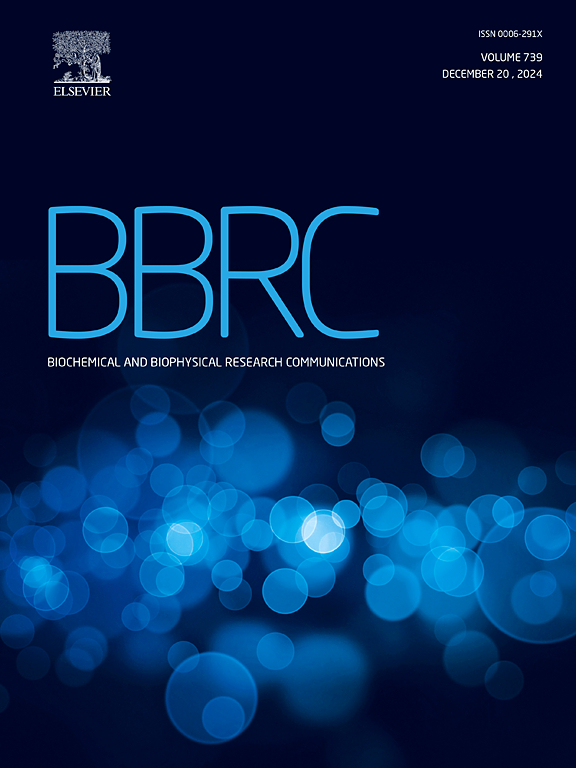内皮源性一氧化氮影响高壁剪切应力条件下的血管平滑肌细胞表型。
IF 2.5
3区 生物学
Q3 BIOCHEMISTRY & MOLECULAR BIOLOGY
Biochemical and biophysical research communications
Pub Date : 2024-11-15
DOI:10.1016/j.bbrc.2024.151005
引用次数: 0
摘要
血管平滑肌细胞(SMC)的表型状态对了解血管病理生理学至关重要。血管中的平滑肌细胞通常表达一组特定的收缩蛋白,但收缩蛋白表达的减少表明表型发生了转变,这是血管疾病的一个特征。最近的研究表明,约 20 Pa 的异常高壁剪应力(WSS)与主动脉疾病的发病机制有关。然而,由于缺乏评估 SMC 表型状态的适当实验模型,高 WSS 条件下表型转变的细节仍不清楚。在本研究中,我们建立了一个共培养模型,将血管内皮细胞(EC)与表达钙调蛋白 1(一种参与 SMC 表型转变的收缩蛋白)的 SMC 进行共培养。我们研究了病理性高 WSS 条件对 SMC 表型状态的影响。与生理状态下的 2 Pa 相比,暴露于 20 Pa WSS 时钙调蛋白 1 的表达增加,而另一种收缩蛋白α-平滑肌肌动蛋白(αSMA)的表达则保持不变。此外,在 20 Pa WSS 条件下,与 2 Pa 相比,与血管疾病中内皮功能障碍有关的一氧化氮(NO)被抑制后,αSMA 和 Calponin 1 的表达呈下降趋势。 我们的研究结果表明,在病理高 WSS 条件下,EC 源性 NO 可能会影响与主动脉病理生理有关的收缩蛋白的表达。本文章由计算机程序翻译,如有差异,请以英文原文为准。
Endothelial-derived nitric oxide impacts vascular smooth muscle cell phenotypes under high wall shear stress condition
The Phenotypic states of vascular smooth muscle cells (SMCs) are essential to understanding vascular pathophysiology. SMCs in vessels generally express a specific set of contractile proteins, but decreased contractile protein expression, indicating a phenotypic shift, is a hallmark of vascular diseases. Recent studies have suggested the relation of abnormally high wall shear stress (WSS) of approximately 20 Pa with the aortic disease pathogenesis. However, due to the lack of appropriate experimental models to assess SMC phenotypic states, the details of the phenotypic shift under high WSS conditions remain unclear. In this study, we developed a coculture model where vascular endothelial cells (ECs) were cocultured with SMCs expressing calponin 1, a contractile protein involved in the phenotypic shift of SMCs. We investigated the effects of a pathologically high WSS condition on the phenotypic states of SMCs. Increased calponin 1 expression was found upon exposure to 20 Pa WSS compared with a physiological 2 Pa condition, whereas the expression of another contractile protein, α-smooth muscle actin (αSMA) remained unchanged. Furthermore, the inhibition of EC-derived nitric oxide (NO), which is associated with endothelial dysfunction in vascular diseases, resulted in a trend of decreasing αSMA and Calponin 1 expression under 20 Pa WSS conditions compared with 2 Pa. Our findings suggest that EC-derived NO under pathologically high WSS conditions may impact the expression of contractile proteins implicated in aortic pathophysiology.
求助全文
通过发布文献求助,成功后即可免费获取论文全文。
去求助
来源期刊
CiteScore
6.10
自引率
0.00%
发文量
1400
审稿时长
14 days
期刊介绍:
Biochemical and Biophysical Research Communications is the premier international journal devoted to the very rapid dissemination of timely and significant experimental results in diverse fields of biological research. The development of the "Breakthroughs and Views" section brings the minireview format to the journal, and issues often contain collections of special interest manuscripts. BBRC is published weekly (52 issues/year).Research Areas now include: Biochemistry; biophysics; cell biology; developmental biology; immunology
; molecular biology; neurobiology; plant biology and proteomics

 求助内容:
求助内容: 应助结果提醒方式:
应助结果提醒方式:


